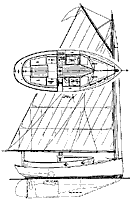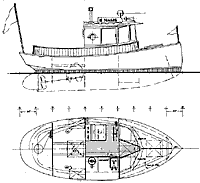20' Catboat Joy & Tug Yacht

|
Design Number 137
1976 |
 |
 |
Some designs seem to spring to life, inspired by just the right spark, either in the form of a suggestion from a
client or an inspiration from another source. This 20' catboat is one of them.
In the spring of 1976 we received a very interesting letter from Al Lewis. In it he said,
"I wonder if you would design a catboat for me.... I have been studying the books and journals for several
years and have come across photographs of boats Mr. Benford has designed and they have given me great pleasure
just to look at them. His Puffin has particularly delighted me....
"...Reflecting further, I believe that if I had a design for a neat little....keel cat I might.... proceed
with a....boat.... I had planned to sail her in the Columbia River and perhaps in the San Juan's....
"What I think I would like in a....cat is a beefy, beamy keelboat big enough to sleep two in the cabin and
two or three (athwartship?) in the cockpit under a boom tent; a small galley and head; an inboard diesel
engine powering a nice big prop. Perhaps twin bilge keels might be considered to avoid an overly deep draft
but not if it will make her too slow in stays. I read that keelcats are already bad in this regard. I am
uncertain as to whether I would be trailering the boat or mooring it in Puget Sound somewhere; most likely
the latter. I still like lots of sheer and tumblehome and like the looks of a round counter-stern, cruiser
stern or even a fantail. Bow would be tumblehome, plumb & sharp, or canoe. A classical gaff rigged "up
and down "mainsail looks beautiful, loose footed or laced, whichever....
"I would think an LOA of 20' or so would be enough to incorporate the features I have mentioned, but smaller
would be just fine and a little larger possibly OK too. The beam would be about half the LWL.
"The enclosed check....should be applied to the cost of a preliminary design if you agree to undertake the job."
This one struck just the right note with me. A couple days later I sent back the following letter:
"Thank you for your letter of April 15th, and your expression of interest in our designs. The project you
outlined took my fancy with its potential, and the enclosed print is the result. I think it ought to make
a very handsome little cruiser, and we'd be delighted to have the opportunity to do up the plans!..."
 |
 |
The drawings that follow are the result of the design commission that resulted. The final boat is very close to
the preliminary design I had laid out, having been so well inspired by the original request.
Quite a number of sisterships have been built and there is a mold for the hull that was taken from the original
hull built for Al Lewis, from which several 'glass hulls have been pulled.
Some time after we'd done the design for the original catboat version, and the mold had been made from the hull,
we started thinking about what sort of pocket cruiser could be created on that hull.
The 20' Cruiser or Tug Yacht is the result of that sketching. Several have been built from the molded hulls and
at least one in wood. They have proven to be capable cruisers and the reports we get back from the owners
indicate that they're having a lot of fun with them.
The drawings indicate a Yanmar diesel that's no longer a current model. I'd suggest their 1GM10 with a 3.2:1
gear as the current choice for a substitution. Of course, as further years come along, the choice of current
models will change. The main point is that an engine in the six to ten horsepower range is what's needed and to
get the most reduction you can so that the prop size is large enough to have good thrust. The engine compartment
is roomy enough to let a variety of different engines fit in it, and the beds will just have to be modified to
take into account differences in width and height of the mounts.
What about a centerboard version? We've done some sketching on a centerboard alternative version, but the
drawings are not fully completed or detailed. We've kept the board narrower than in traditional cats, to keep
the trunk unobtrusive in the cabin and not push up the engine too much into the cockpit. The board would be a
thick (10-15% of chord length) NACA foil shape to provide good lift.
| Particulars: | Imperial | Metric |
|---|
| Length overall | 20'-0" | 6.10 m |
| Length designed waterline | 18'-0" | 5.49 m |
| Beam | 8'-0" | 2.44 m |
| Draft: | Cat | 3'-6" | 1.07 m |
| Tug | 2'-3" | 0.69 m |
| Freeboard: | Forward | 3'-7½" | 1.10 m |
| Least | 2'-0" | 0.61 m |
| Aft | 2'-6" | 0.76 m |
| Displacement, cruising trim: | Cat | 5,260 lbs. | 2,385 kg |
| Tug | 4,800 lbs. | 2,177 kg |
| Displacement-length ratio: | Cat | 403. | |
| Tug | 367 | |
| Ballast: | Cat | 1,600 lbs. | 726 kg |
| Tug | 750 lbs. | 340 kg |
| Ballast ratio: | Cat | 30% | |
| Tug | 16% | |
| Sail area | 310 sq. ft. | 28.8 sq. m |
| Sail area-displacement ratio | 16.4 | |
| Prismatic coefficient | .557 | |
| Pounds per inch immersion | 466 | 83 kg/cm |
| Entrance half-angle | 26° | |
| Water tankage: | Cat | 14 Gals. | 53 liters |
| Tug | 20 Gals. | 76 liters |
| Fuel tankage: | Cat | 15 Gals. | 57 liters |
| Tug | 30 Gals. | 114 liters |
| Headroom: | Cat | 5'-0" | 1.52 m |
| Tug | 6'-3" | 1.91 m |
*CAUTION: The displacement quoted here is for the boat in cruising trim. That is, with the fuel
and water tanks filled, the crew on board, as well as the crews' gear and stores in the lockers. This should
not be confused with the "shipping weight" often quoted as "displacement" by some manufacturers. This should
be taken into account when comparing figures and ratios between this and other designs.
|
|